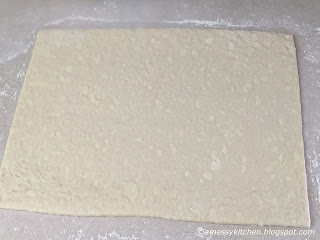Does lamination scare you? Here is a recipe you can try out that eases into the process! I have had a number of "fails" with lamination. Oh, the breads turned out perfectly edible, but nothing smells quite like scorching butter oil that has leaked out as the item bakes.

My consistent issue has been, I finally figured out, with the butter temperature. I keep my fridge really cold, and I have a chest freezer that works pretty fast. Usually with the times listed for chilling in a laminated recipe, I end up with my butter layer too hard, which then breaks into little lumps while rolling out, which in turn messes up the lamination, which results in a lot more butter leakage during baking. It also makes a difference whether the butter is a high fat, less water, European style butter or a cheaper butter which likely has higher water content. For Americans, the most widely available lower moisture butter brands are Plugra, Kerrygold, and Lurpak. Other brands may tend to get hard faster, leading to breakage during lamination and leaking during baking, both from exposed butter melting, and from the extra water steaming and melting the butter. Even while making these rolls, I noticed that the butter got hard enough to break at less than 10 minutes. (I was just using butter on hand.) So I modified my method a little for my kitchen temps: I took the dough out and let it warm up for 5 minutes until the butter felt pliable instead of hard. If I felt breaking while rolling, I stopped and let it sit for a while longer. Fingers crossed! The trick is for the butter and dough to be about the same temperature, which is more of a challenge than one might assume.
We would love to have you try out this everyday treat with us this month and share how it turned out! Despite my continued battle with lamination, these turned out amazing, with no butter leakage. And they freeze amazingly well and split and toast up even better than fresh. Highly recommend trying them toasted, with butter and whipped honey. New recipes are posted every month on the 16th. Check out our Facebook group to see the participants' baking results during that time. If you would like to post your results with a Buddy badge on a blog, let us know in the comments or on the Facebook page.
Easier Flaky Crescent Rolls
makes about 18-20 rolls
¼ cup warm water ~105-110ºF [60 grams]
2 ¼ tsp active dry yeast one packet [7 grams]
2 tsp sugar [8 grams]
¾ cup warm milk (not boiling) [183 grams]
1 egg
1 tbsp unsalted butter, melted or softened [14 grams]
1 tsp salt [6 grams]
3 cups all-purpose flour plus more for rolling [375 grams + more for rolling]
8 tbsp salted butter, softened [113 grams]
1 egg beaten and or melted butter, for brushing
Instructions
In a large glass bowl or stand mixer, combine the warm water, yeast and sugar to dissolve the sugar and yeast. Let the mixture sit for about five minutes until it is puffed up and foamy.
Add the warm milk, egg, 1 tbsp butter, salt and flour. Using the dough hook, a dough whisk, or your hands, knead the dough until it is smooth and elastic. The dough will seem sticky at first, but it will eventually become smooth and springy.
Turn out the dough onto a floured work surface. Lightly knead into a smooth ball. Put the dough back in the bowl, cover and place in the fridge for 30 minutes.
After 30 minutes, turn out the dough onto a lightly floured surface. Roll out a large rectangle that is about ¼-inch thick. Gently spread the 8 tbsp softened butter all over dough, leaving about an inch around the sides of the rectangle.


Roll the dough again into a long rectangle (being careful of the butter - if it is breaking, let it warm up for a while longer) and fold dough again into thirds like a book. Place back in freezer for 5-7 more minutes. Repeat this process two more times for a total of three folds (and 30 minutes in the freezer.) (I ended up just going to the refrigerator for my last chill, the butter was hardening too fast.)
After the three folds, you can either go ahead and shape for baking or you can wrap your dough tightly with plastic wrap and place in the fridge overnight or up to three days.
To shape, roll the dough out on a lightly floured surface into a rectangle about ¼-inch thick. Using a pizza cutter or sharp knife, cut the dough in half lengthwise, cut the strips into triangles. Roll each crescent up using both hands.
 |
| Broken butter bits - butter was too cold. |
While the rolls rise, position a rack in the middle of the oven and preheat to 400ºF. Before baking, brush each crescent with the beaten egg wash. Bake rolls for 10-14 minutes or until lightly golden brown. If desired brush with melted butter. Serve warm with butter and honey or jam.












